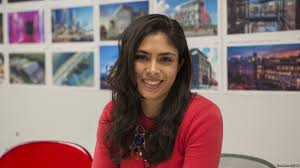Brazilian Zarela Mosquera moved to the United States as a teenager. The adjustment to a new place was difficult. Mosquera says she was a bratty teenager, as a result. But it was not just the adjustment that affected her behavior. Mosquera says there was another major stress in her life at that time: She was the only member of her family who spoke English.
"Being in a country with my family that doesn't speak Spanish and my parents don't really speak English, my parents were trying to give me all these responsibilities."
Along with Spanish and English, Mosquera also speaks Portuguese. But there was another universal language she learned to love as a child: art.
Mosquera connected with drawing and painting while in school. But she mostly dismissed art as a path to a career.
She says her Dad would always say, "Think about the future."
Mosquera did not think he would support the study of art once she went to college.
But, to her surprise, it was her parents who suggested just that. They urged her to apply to technical and liberal arts schools.
"One of them was Rhode Island School of Design so that was like my top choice."
RISD, as it is called, chose Mosquera as well. She enrolled in industrial design.
"It's basically to design products and services. I could be doing something more technical or something more related to problem solving. Whether it's figuring out a better way to filter water or developing a type of specific shelter for refugees for example."
Mosquera says the course of study was tough including metal working, woodworking and model making.
She says in one class she just drew cubes for an entire month, which led her to a question:
"Wow! Do I really want to do this?"
But, she says, she survived the cube study. And, then began working on more interesting projects.
"So you start kind of divinv more into the creative process when you have a strong foundation and design. And my school is really big on material understanding as well, which is why we're trained to use every imaginable tool there is like table saw, band saw everything because they give you an understanding of material. And when you have that understanding, that's when you can start designing things that are functional and also form driven."
Mosquera is now a design strategist for Marshall Moya Design, an architecture and interior design company in Washington, D.C.
Her job, Mosquera says, is to find the best solutions for a client need. She also supports the architecture team and branding department.
"I have experience in exhibit design, product design, website design and textiles. I've been using all of the experience that I've had and all the different skills that I've gained."
Mosquera also has a long-lived and deep interest in public art. This year, she helped create and design "The Walkway," for the D.C government.
"They wanted to see public art that was related to street harassment and to the public realm and how that affects pedestrian safety."
The creation was a 11-meter long tunnel-like structure. It was built to narrow sharply as the walker moves through. Bright lights change color along the path.
On the walls are images of people. Voices and city sounds are played through speakers installed in the walkway. At first, the recorded conversations and street noise and pictures have a positive feel. But the images and audio increase in intensity along the path. The experience becomes dark and violent in the middle part of the walkway.
"The purpose of showing these two different human emotions and human reactions is to allow people to reflect upon a variety of different expressions. So that brings up the conversation as to what is the right way to talk to each other in a public space. Should we talk to each other at all? So people are really questioning that. And that's what public art is meant to do."
For Mosquera, the form of the structure created the greatest impact.
"In a couple of steps, it changes pretty drastically and so actually feeling it versus just seeing it in a drawing was really impactful."
She enjoys developing public art in her free time, too.
"Throughout my career, I've picked up different things along the way. The best way to learn in my opinion is through working. Getting as many projects as you can. Industrial design kind of makes you a jack of all trades."











